In the era of technology, eCommerce platforms play a very important role in the contribution to this industry developments.
BigCommerce is a hosted shopping cart store builder that provides 49,000 online stores. It has helped almost 100,000 people start selling online, offering the most built-in features of any eCommerce platform.
On the contrary, Magento is known as one of the most popular Content Management Systems (CMS) with 160,000 online stores, accounting for 12% of all online retail stores, powering 1.2% of the internet. Magento is more popular than BigCommerce, the stats below will specifically demonstrate their popularity according to Google Trends:
Comparing the keyword data searching result, we can easily see that Magento is a more preferable option among e-merchants.
In this article, we are going to share why it is beneficial to move your store from BigCommerce to Magento and how to perform the migration.
Perks of migrating from BigCommerce to Magento
-
Themes and interface customization
It is important for an eCommerce platform to have various themes and customizations that can serve the best design for each website’s themes. With BigCommerce, pre-built responsive templates are available with 12 free themes and 100+ paid options which cost from 145$ to 235$ each. However, Hundreds of free and paid themes but too similar to each other are the precise words to describe BigCommerce themes and designs.
On the other hand, Magento offers 14 theme options in total both free and paid and users can see how their website will look like with the theme before you decide to pay. Although Magento does not have many themes, you can get endless design customization possibilities because of Magento open-source nature. Magento has many free and paid themes available, customized by using HTML/CSS editor. BigCommerce also allows users to edit the HTML/CSS of a page but it still does have some limitation:

With Magento, you can even create your theme from scratch but this requires you to have deep coding knowledge, or you can hire developers to do it for you. Thanks to Magento open-source nature, users can access source code in order to customize more features easier than BigCommerce. Magento has these highlight features:
+ It offers more flexible Customization.
+ It allows you to add animations to make your store engaging.
+ Add a featured product slider to your homepage.
+ You can incorporate newsletter options in your webpage footer.
+ Place ‘cross-selling blocks’ on your product pages.
-
Apps and extensions
While themes create the outlook for your website, however, if you want an online store with many functions, adding extensions is a solution for you. Most of the applications are just a click away, allowing you to add multiple features to your eCommerce site.
BigCommerce provides many strong built-in features as a hosted platform, which is helpful for your online store. It also provides a wide range of apps for you to expand the functions of your store with 600 apps belonging to different categories.
Magento provides more than 5381+ extensions through the Magento marketplace. Magento Marketplace is carefully curated with every extension checked for coding standards, compatibility, and security.
-
Payment options and fees
BigCommerce offers over 65 integrated payment gateways to its users, including big names like PayPal, Apple Pay, Stripe, and Amazon Pay. It also comes with no transaction fees on all price plans and pre-negotiated rates with PayPal, saving you even more money.
If you choose to go with Magento, you have to use third-party payment methods. PayPal and Braintree are the default payment methods for Magento’s customers, the rest could be added depending on your preferences using Magento Connect. There are 364 Apps in the Magento Marketplace for you to pick. On top of that, you are able to use great features like one-click payments, guest checkouts.
LitExtension has made a detailed BigCommerce vs Magento comparison if you wish to know more.
BigCommerce to Magento Migration: Best practices
1. Preparation
Step 1: Data backup
Backing up your database (customers, orders and products, etc.) is the very first thing you should notice when making any changes to your online store. This is greatly important because it protects your business-critical data in any case.
However, when migrating your data from BigCommerce to Magento with LitExtension, you don’t have to worry about any distortions of your data because we will not, in any way, edit anything on your Source Store. Therefore, it is not compulsory for you to do backup data before migration.
The following information will show you how to backup your BigCommerce database, just in case.
Keeping up with these steps will be all you need to take to export your BigCommerce products, you can follow the same process to export orders and customers. When exporting your products and product images from your BigCommerce store, be sure to export additional product and variant information.
#1. From your BigCommerce dashboard, go to ‘Products’ > ‘Export’.
#2. Under Export Template and File Format Options, select ‘Default’ and then click Continue.
#3. In the Products dialog box that appears, click ‘Export my Products to a CSV file’ and then click ‘Close’. A CSV file containing your product data is saved to your computer.

#4. A status bar will move across the screen. When it finishes, click Download my Products file to save the file to your computer.
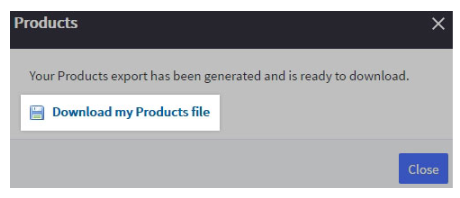
#5. Connect to your store using WebDAV which is an application that allows you to upload files to your store’s server. Download the product_images folder by dragging and dropping it to your desktop.

Step 2: Install new Magento store
After completing the backup data, the next thing to do is to install a new store in Magento to prepare to go into operation.
- Prerequisites To Install Magento 2
- Download Magento Software Market
- Set up FTP
- Transfer Magento Archive To Your Hosted System With FileZilla
- Running Setup Wizard
Here is the link to the detailed instructions which will help you during your set up.
2. Data migration
And now let’s get started with the migration work!
For the transfer of data from BigCommerce to Magento, you can do it manually. However, the problem is that if you can not fully understand the data structure between two platforms, some errors like duplicate or missing data will happen.
At LitExtension, we provide fully automated Magento migration service with high accuracy with a few simple steps. We are now supporting migration from 100+ carts, for over 50,000 customers worldwide and have successfully migrated over 150,000 stores.
LitExtension’s automated service allows you to change your source data securely, accurately, and quickly within a few hours. We can transfer products, categories, customers, orders, domain, multilingual sites, SEO URLs ranking or Customers Password.
Let’s get down to the detailed process of BigCommerce to Magento migration.
Step 1: Create a LitExtension account
To begin with, you need to get access to LitExtension website and Create a new account or Sign in if you already have one. In addition, you can also use your personal email address or Facebook account to get access to our migration service.
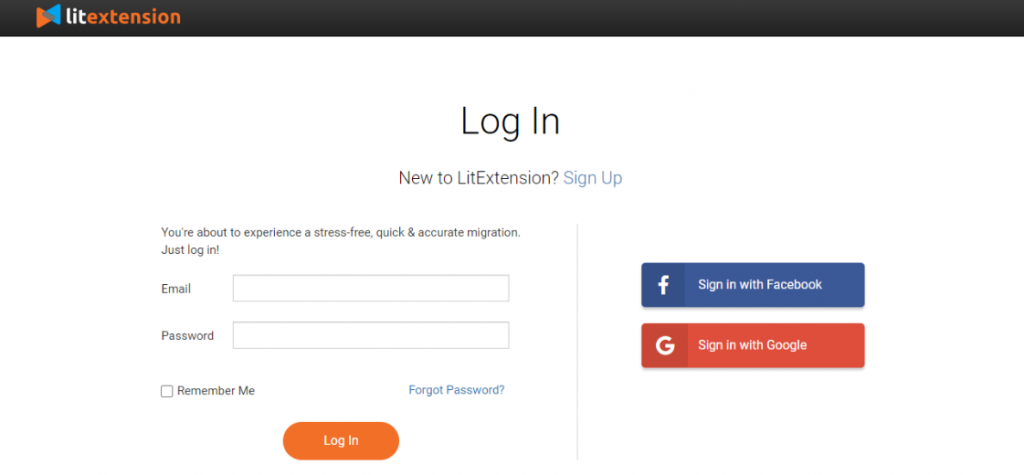
Step 2: Fill in information
After registering on LitExtension, select “Create new migration” to start setting up all necessary information for your data transfer.
To set up your shopping cart, select BigCommerce as your source cart type, and provide the store URL. Then you need to enter the BigCommerce API, if you don’t know how to do it, click the Youtube icon, follow the brief instruction to get your API info and fill them in the form.
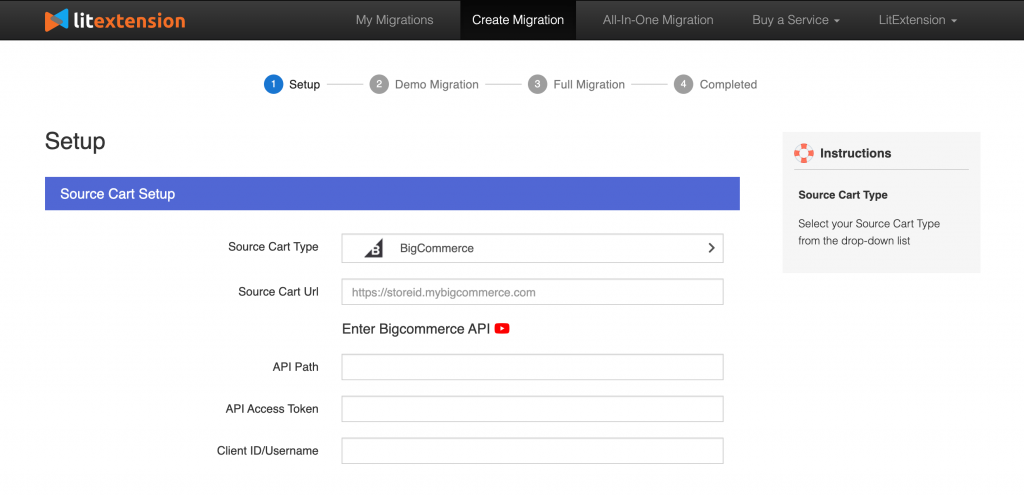
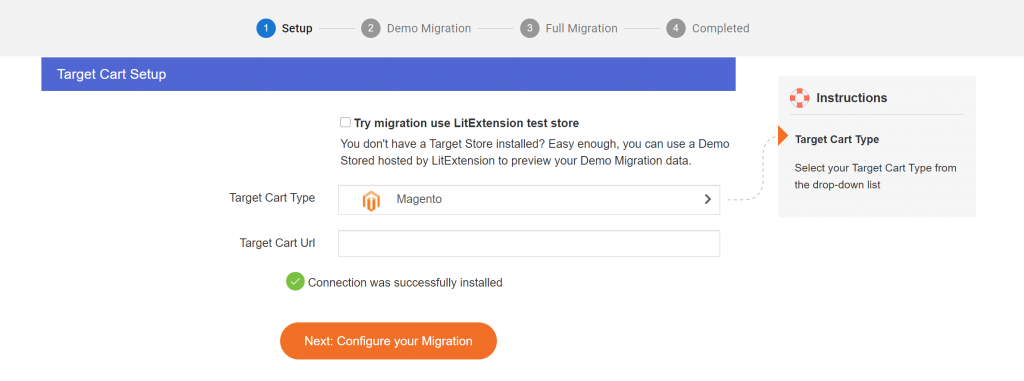
Step 3: Configure migration
You can select entities that want to migrate such as products, customers, orders or you can choose the Select All option. LitExtension also supports extended options for you to have an effective and proper migration. For example, migrate customers’ passwords will help you to transfer customers’ accounts and passwords from the old store to the new one, making it possible for customers to log in as soon as the new store goes into operation without encountering any trouble.
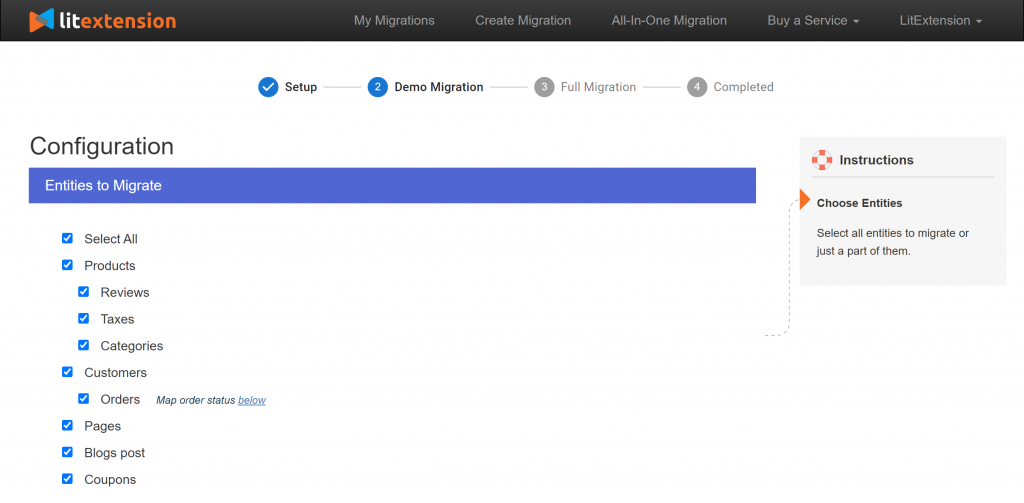

Step 4: Perform migration
It’s time to start the migration process. We recommend that you try out the Free Demo migration to get a handle on how the LitExtension tool works. Then, once you got the result, you can start running Full Migration.
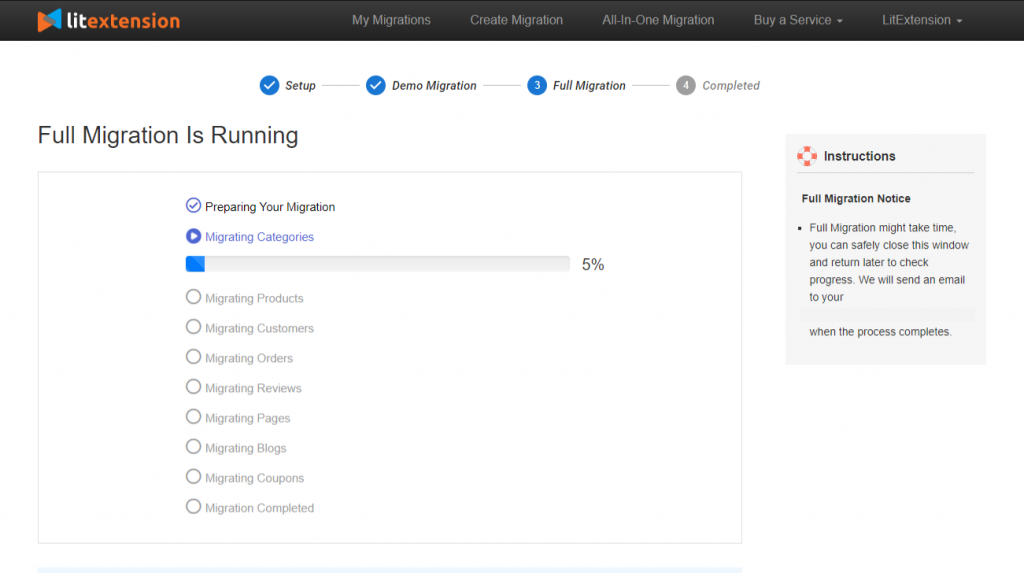
Once you start the migration, it will run seamlessly on the server. Therefore, there’s no need to keep your PC on while transferring the data . It is completely safe to turn it off! Take a break, have a cup of coffee and you’ll be notified via email when the process is completed.
Step 5: Check results after migration
After the migration process has completed, all of your products will be displayed on the storefront. Click on the “Check Result” button to check whether all data have been transferred accurately from BigCommerce to Magento.

Make sure that you check your products details carefully including product descriptions, images, variants and meta descriptions. In case you wish to know more about the result after the full migration, please check the step-by-step guidance.
If there are any errors or problems after the migration, contact the LitExtension support team as soon as possible.
3. Migrate extensions and custom codes
You may have some of the extensions installed in BigCommerce to help you run your business and not want to lose those settings. To do that, we need to find similar applications on Magento, then we will help you with the data transfer job.
However, there is a note that you must know when you migrate extensions: extensions data of Source Store can only be migrated to the same function extensions data of Target Store. For example, data from an extension in BigCommerce that allows you to organize products can only be migrated when there is a same extension with the same function as in Magento. Moreover, you have to export the CSV files from the extensions data in the Source store if you want to have a possible migration.
In addition, you also have functionalities created by custom code in BigCommerce and want to keep them in Magento. At LitExtension, we can help you move your custom code to your new store. We will analyze and make these custom codes suitable for your new store.
4. Post-migration activities
Here are some post-migration steps you should take before your store can go live!
- Install new themes
- Add new extensions
- Recent data migration
- Change DNS and switch domains
- Testing
You can visit our article about recommended practices after Magento migration here for more specific instructions!
Besides the Magento migration, you can upgrade Magento 1 to Magento 2 with LitExtension in simple steps.
Conclusion
In conclusion, I have shown you the detailed instructions to migrate your online store from BigCommerce to Magento using LitExtension tool. We, LitExtension team, hope to provide you the best migration services that guarantee accurate performance and the best level of security to your data.
Currently, LitExtension is supporting over 100 shopping carts migrations, 150.000 successful migrations for over 50.000 customers so far. If your platform is already in our shopping cart list, you can run the migration immediately with LitExtension service. However, if your website platform is not on the list, contact our live support team to make a request. Let’s join our community to get more eCommerce knowledge.
If you have any concerns or questions about your store migration, please don’t hesitate to contact us. LitExtension team will always be available to support you.